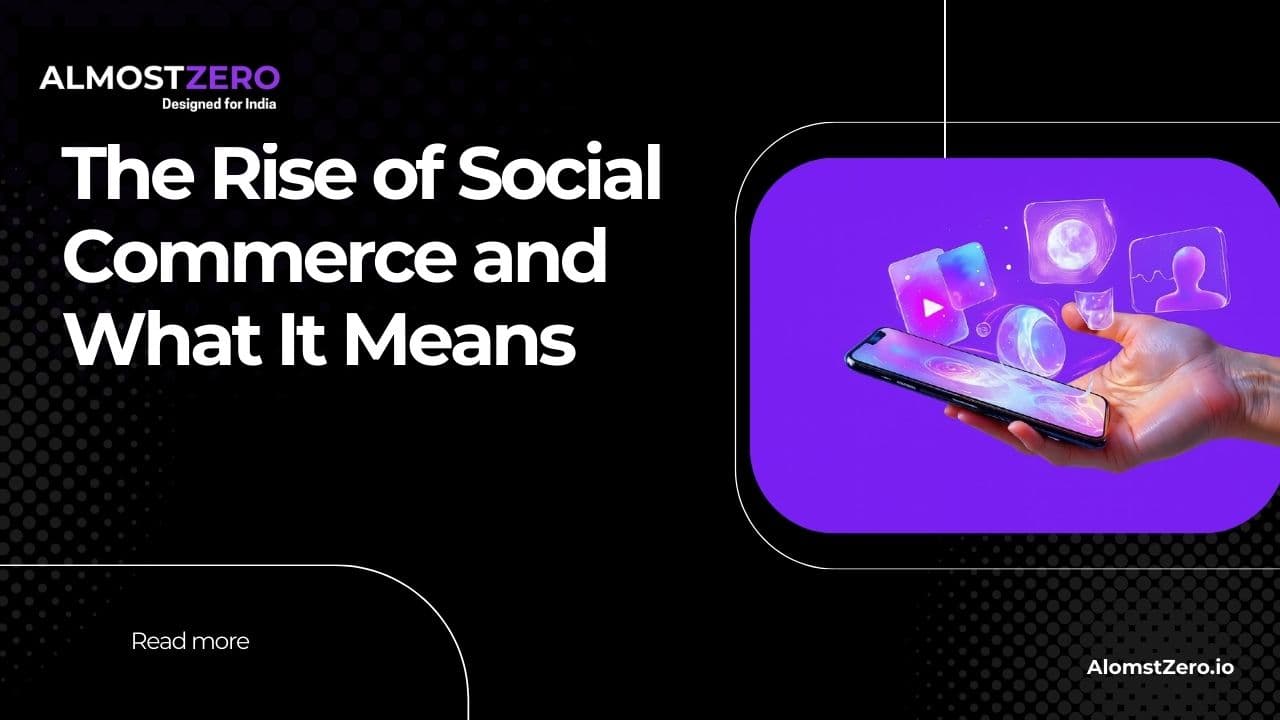AlmostZero.io The Rise of Social Commerce and What It Means

The Rise of Social Commerce and What It Means
Shopping is no longer limited to malls, websites, or apps—it’s happening right where people spend most of their time: social media. Platforms like Instagram, Facebook, TikTok, and even WhatsApp are becoming full-fledged shopping destinations. This trend, known as social commerce, is transforming how people discover, evaluate, and buy products online. For businesses, this shift is not just an opportunity—it’s a revolution that changes how brands must connect with customers.
1. What Is Social Commerce?
Social commerce is the integration of shopping directly into social media platforms. Instead of clicking ads that redirect to websites, users can browse, add to cart, and check out without leaving the app. From Instagram Shops to TikTok Shopping and Facebook Marketplace, social commerce makes buying seamless.
2. Why Social Commerce Is Growing
Several factors are fueling this rise:
- Convenience: One-click purchases without leaving the app.
- Trust: Social proof through reviews, likes, and shares.
- Entertainment + Shopping: Short videos and live streams drive impulse buys.
- Mobile-first behavior: Social media is where users spend the majority of their screen time.
- This blend of engagement and shopping is exactly why social commerce is booming.
3. Social Proof Drives Conversions
People trust people. Seeing friends, influencers, or communities using a product makes buyers feel more confident. Social commerce thrives because it leverages user-generated content, influencer recommendations, and real-time feedback to drive conversions faster than traditional e-commerce.
4. The Role of Influencers in Social Commerce
Influencers have become virtual shopkeepers. Instead of just promoting, they now sell directly through live streams or shoppable posts. For example:
- Instagram creators tagging products in posts.
- TikTok influencers hosting live product demos.
- YouTubers linking products directly within videos.
- This makes influencer marketing far more transactional than ever before.
5. Live Shopping: The New QVC
Live commerce is gaining traction worldwide. Brands host live streams to showcase products, answer questions, and offer limited-time discounts. This interactive format combines entertainment with urgency, creating high-conversion events. In markets like China, live shopping is already a billion-dollar industry, and it’s quickly growing in India and globally.
6. Personalization in Social Commerce
Algorithms already know what users like, follow, and engage with. Social commerce leverages this data to deliver personalized product recommendations. For example:
- Instagram suggesting fashion items based on your browsing.
- TikTok’s “For You” page showing shoppable videos aligned with your interests.
- This hyper-personalization makes discovery effortless and conversions faster.
7. How Social Commerce Impacts Businesses
For brands, social commerce brings both opportunities and challenges:
- Opportunities: Direct sales, increased engagement, reduced friction, and new revenue streams.
- Challenges: Higher competition, reliance on platform rules, and the need for fresh, engaging content.
- Businesses must adapt their marketing strategies to embrace selling within social platforms, not just driving traffic away from them.
8. Social Commerce vs Traditional E-commerce
- Traditional E-commerce: Users go to websites or apps to shop.
- Social Commerce: Shopping happens inside the social media experience itself.
- The key difference is discovery-driven buying—users don’t always plan to shop but end up purchasing because of engaging content.
9. The Power of Community in Social Commerce
Communities, groups, and niche audiences are central to social commerce. A skincare product recommended in a beauty group or a gadget reviewed in a tech forum carries more weight than generic ads. Social commerce thrives on these community-driven buying behaviors.
10. Future of Social Commerce
In 2025 and beyond, expect to see:
- AR Shopping: Trying on clothes, makeup, or furniture virtually before buying.
- AI-Powered Personalization: Smarter product recommendations based on user behavior.
- Cross-Platform Integration: Shoppable posts that work seamlessly across Instagram, WhatsApp, and Facebook.
- Social commerce is not a trend—it’s the future of online retail.
11. Real-Life Examples of Social Commerce in Action
- Instagram Shops: Brands selling products directly through tagged posts and stories.
- TikTok Shopping: Viral products like beauty gadgets exploding in sales after trending videos.
- WhatsApp Catalogs: Small businesses using catalogs for direct selling and customer conversations.
- These examples show that social commerce is accessible to both big brands and small sellers alike.
The rise of social commerce means businesses can no longer rely only on traditional e-commerce. Customers are shopping while they scroll, and brands that adapt will win. By blending content, community, and commerce, social media is shaping the future of how we buy.
At AlmostZero, we help businesses unlock the full potential of social commerce. From creating shoppable content to running influencer campaigns and optimizing in-app conversions, we make sure your brand doesn’t just keep up but stands out.